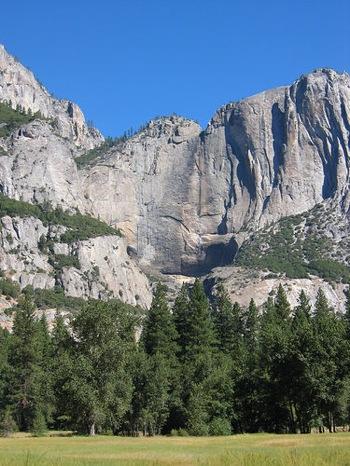Check out this strange picture. At first glance, it looks like a fake, as if someone has edited out the waterfall. It's the real deal though, Yosemite Falls has dried up this summer. The story appeared in the Modesto Bee this week:
The winter's stingy snowpack, 24 percent of normal by the end of April, set the stage for the thirsty summer. Waterfalls in Yosemite Valley peaked in mid-April, six weeks earlier than usual. The fire season was declared a month early.
The dry falls seem out of place, but the real problem is what the dry falls represent - fire hazard. Yosemite National Park spokesperson Adrienne Freeman had this to say about the fire situation in the park, "the fire danger remains to be seen; it depends a lot on the weather. We're ready. We will react quickly and strongly. But this ecosystem needs naturally caused fires, just like it needs rain and snow. Fire is a natural process."
(photo discovered via Yosemite Blog)




Comments
It dries up every year. Bridalveil usually doesn't though.
Any of you mountain climbers in need of a liquid rubberizing dip? Great for coating metal, plastic, rope ends Any ideas please pass them on to me.
Sincerely,
Mike Anderson
Sad to see this picture, I was their back in the 70's We need to stop shipping our water out of the country! Remember to place a plastic Quart water filled container in your toilet tank. I have a gallon jug wedged in mine.
Anon is right. Even after the record snowpack of the winter of 05/06, when the High Sierra Camps couldn't open until very late due to snow, Yosemite Falls was dry by Labor Day. And it was dry by late August the year before that. Nevada and Vernal Falls seem to run year round.
The watershed that feeds Yosemite Creek is very small compared to the massive watersheds for Bridalveil Creek (which feeds Bridalveil Fall) and the Merced River (which feeds Vernal & Nevada Falls). Yosemite Creek's watershed is based around the southern slopes of Mount Hoffman which isn't far from Yosemite Valley. It is natural even in high water seasons for Yosemite Creek to dry up in fall. This year everything is about a month early, due to the low snowpack.
Personally, I find the dry fall beautiful. Usually by November or so, Yosemite Creek begins to trickle again and through the winter falls softly, building a nice ice cone. The cycle is stunning and really beautiful to watch.
Thanks for the info everyone. I had known that it wasn't totally unusual for Yosemite Falls to run dry, but I didn't know that it happened every year. I appreciate all the extra detail you've provided.
It is typical for the falls to dry up at the end of summer. This year with 25% snow pack, things shriveled up earlier. There are no aquifers to feed these streams – all we see is snow melt. Bridal Veil Falls usually runs longer due to its larger watershed (mentioned above) AND the fact that the snow fields feeding it face more north and thus melt slower. In late June, even this fall was mostly spray.
Besides the fire concern, another issue is the bears. With their natural food supply not growing in abundance, they migrate more towards the easy pickins – campers. Even nearby Tahoe is seeing more bruins heading to populated areas and garbage. Many have been hit by cars. Life is seasonal – this too, will pass.